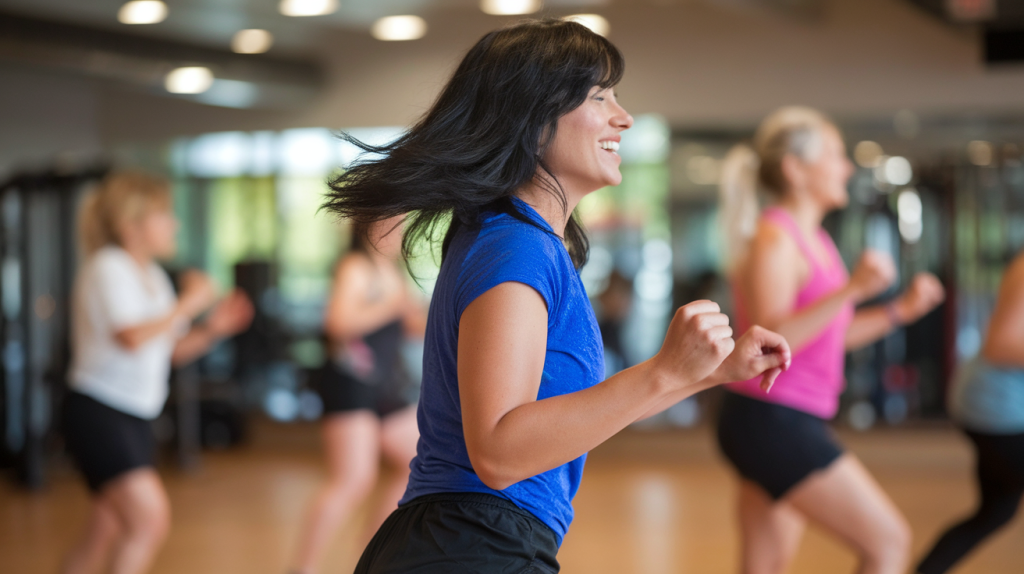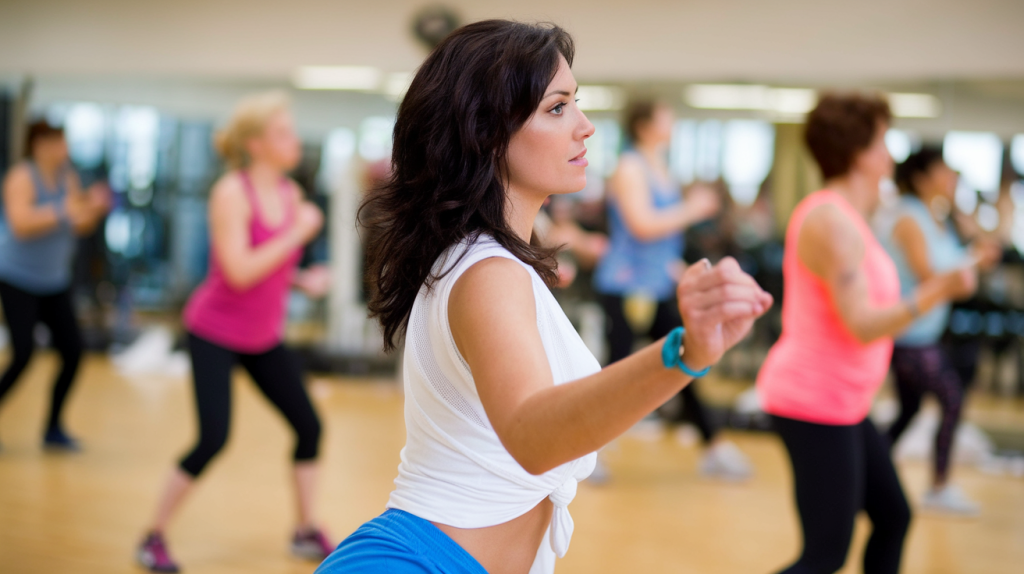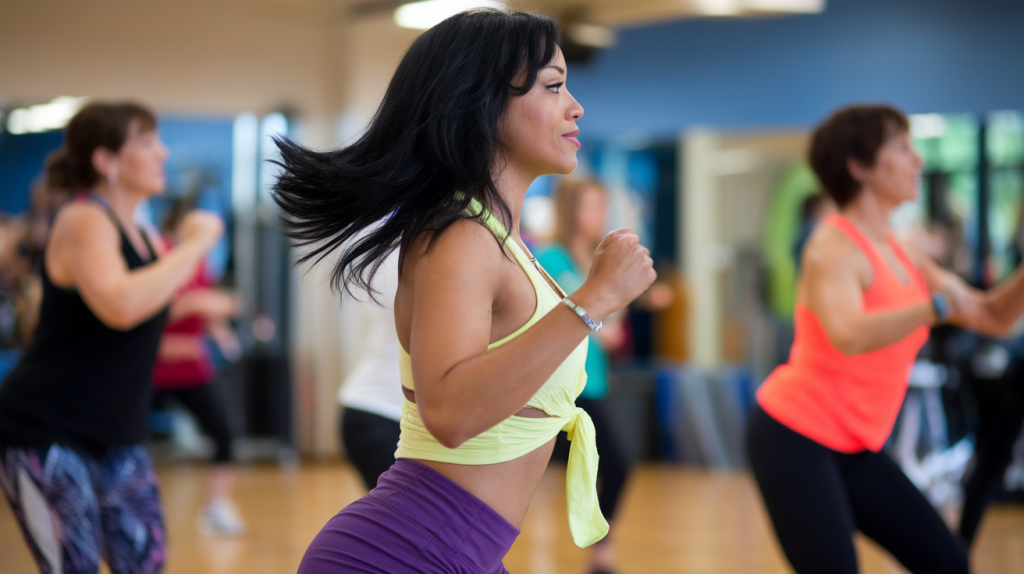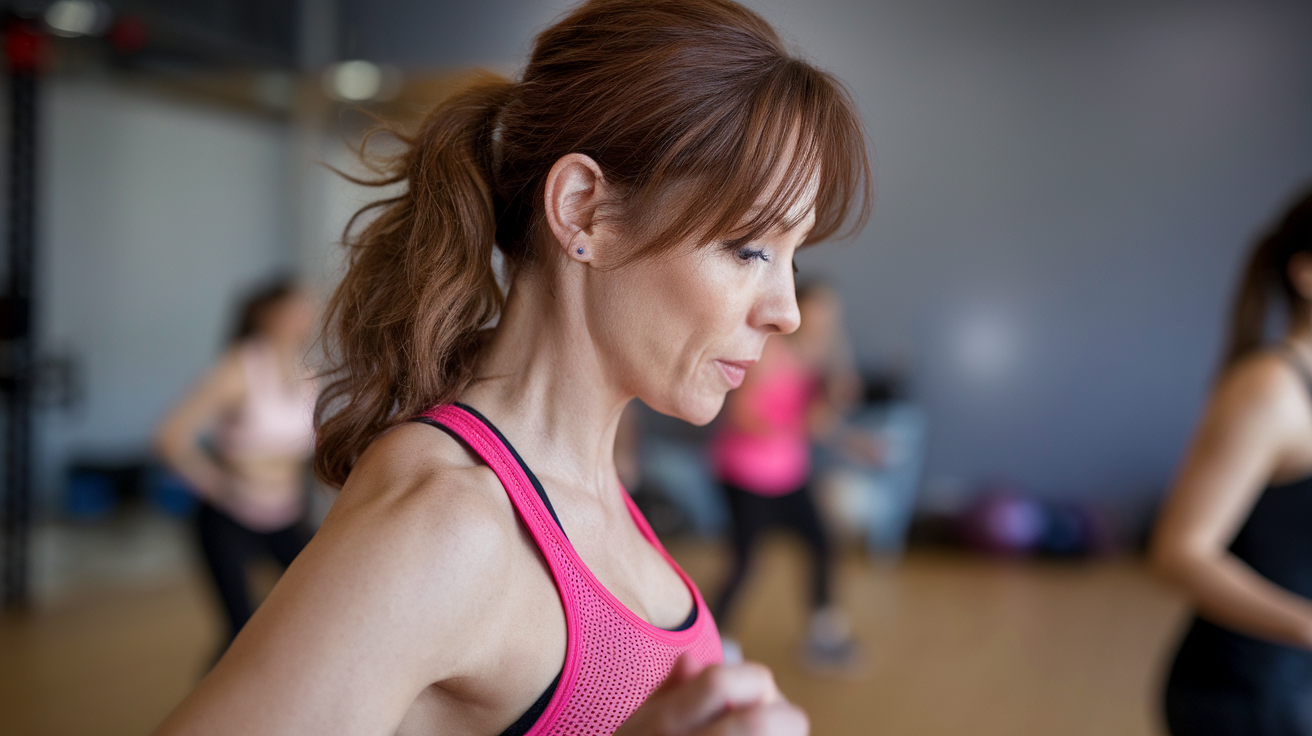Zumba, the popular dance-fitness program, combines Latin and international music with dance moves. This high-energy workout blends cardio exercises with body-sculpting movements, creating a fun and effective way to burn calories. Women of all fitness levels can enjoy Zumba, as it offers both low and high-impact options.
Weight loss often tops the list of fitness goals for many women. Zumba stands out as an excellent choice for shedding pounds. The dynamic, full-body workout engages multiple muscle groups, boosting metabolism and promoting fat burning. Regular Zumba sessions can help create a calorie deficit, essential for weight loss, while also improving cardiovascular health and muscle tone.
Gyms provide the perfect environment for Zumba classes. They offer spacious rooms with proper flooring, high-quality sound systems, and mirrors that help participants follow the instructor’s moves. In the following sections, we’ll explore how Zumba at the gym can help you lose weight and boost your confidence. We’ll also cover tips for maximizing your Zumba workouts, what to wear, and how to overcome any initial hesitation about joining a class. Keep reading to discover how this exciting fitness trend can transform your body and mind.
- How does Zumba at the gym contribute to weight loss?
- What makes Zumba an effective confidence booster?
- How to maximize weight loss with Zumba at the gym
- What should you wear for Zumba classes at the gym?
- How to overcome gym anxiety and enjoy Zumba classes
- Shake, Shimmy, and Shine: Your Path to Zumba Success
- Frequently Asked Questions
How does Zumba at the gym contribute to weight loss?

Zumba at the gym offers a fun and effective way to shed those extra pounds. This Latin-inspired dance workout combines energetic moves with upbeat music, creating an enjoyable exercise experience. But how exactly does it contribute to weight loss?
Calorie-burning potential of Zumba classes
A typical one-hour Zumba session can burn anywhere from 300 to 900 calories, depending on your intensity level and body composition. This high calorie-burning potential makes Zumba an excellent choice for those looking to create a calorie deficit, which is essential for weight loss. The varied movements in Zumba engage multiple muscle groups simultaneously, increasing the overall energy expenditure during the workout.
Comparison with other gym workouts
How does Zumba stack up against other popular gym workouts? Let’s take a look:
- Treadmill running (6 mph): 600-800 calories per hour
- Cycling (moderate intensity): 400-600 calories per hour
- Swimming (moderate pace): 500-700 calories per hour
- Zumba: 300-900 calories per hour
As you can see, Zumba holds its own against traditional cardio exercises. What sets it apart is the enjoyment factor. Many women find Zumba more engaging than repetitive machine-based workouts, which can lead to better consistency and long-term results.
Frequency of Zumba sessions for optimal results
To achieve noticeable weight loss results, aim for at least 2-3 Zumba sessions per week. This frequency allows your body to recover between workouts while still maintaining a consistent calorie burn. As you build stamina and become more comfortable with the routines, you can gradually increase the number of sessions or their intensity.
Remember, consistency is key. Regular attendance at Zumba classes, combined with a balanced diet, will yield the best weight loss outcomes.
Impact on metabolism and fat burning
Zumba’s high-intensity intervals can boost your metabolism long after the class ends. This phenomenon, known as excess post-exercise oxygen consumption (EPOC) or the “afterburn effect,” means your body continues to burn calories at an elevated rate for hours following your workout.
Moreover, the dynamic movements in Zumba help build lean muscle mass. Increased muscle tissue raises your basal metabolic rate, allowing you to burn more calories even when at rest. This dual impact on metabolism makes Zumba an efficient fat-burning workout.
Combining Zumba with other gym activities
While Zumba alone can lead to significant weight loss, combining it with other gym activities can enhance your results. Here’s how you can create a well-rounded fitness routine:
- Strength training: Add 2-3 strength sessions per week to build muscle and further boost your metabolism.
- Yoga or Pilates: Incorporate these for flexibility and core strength, complementing the cardio benefits of Zumba.
- High-Intensity Interval Training (HIIT): Alternate between Zumba and HIIT workouts for varied cardiovascular challenges.
- Swimming or cycling: Use these low-impact options on rest days to maintain activity without overstraining your body.
By diversifying your workouts, you’ll target different muscle groups, prevent boredom, and reduce the risk of overuse injuries.
Zumba’s effectiveness for weight loss stems from its high calorie-burning potential, positive impact on metabolism, and enjoyable nature that promotes consistency. When combined with a varied gym routine and proper nutrition, Zumba can be a powerful tool in your weight loss journey. So, put on your dancing shoes and get ready to shimmy those pounds away!
What makes Zumba an effective confidence booster?

Zumba isn’t just about burning calories and getting fit. This dance-fitness program has a secret superpower: it’s a remarkable confidence booster. Let’s explore how shaking your hips and moving to the beat can transform not just your body, but also your self-esteem.
Dance-based movements and self-expression
The core of Zumba lies in its dance-based movements. Unlike traditional workouts that focus on repetitive exercises, Zumba encourages you to express yourself through dance. As you sway, spin, and shimmy, you’re not just working out – you’re letting your personality shine through your movements.
This form of self-expression can be incredibly liberating. It allows you to break free from your everyday persona and tap into a more vibrant, energetic version of yourself. Over time, this freedom of expression in class can translate into more confidence in your daily life.
Social aspect of group Zumba classes
Zumba classes are typically group affairs, and this social aspect plays a crucial role in boosting confidence. Here’s how the group dynamic works in your favor:
- Shared experience: You’re all in it together, sweating and having fun.
- Supportive environment: Instructors and classmates often cheer each other on.
- Reduced self-consciousness: In a room full of people moving, you’re less likely to worry about how you look.
- New friendships: Regular classes can lead to social connections outside the gym.
The camaraderie developed in these classes can help you feel more comfortable in social situations beyond the gym, gradually building your overall confidence.
Endorphin release and mood elevation
Ever heard of the “runner’s high”? Zumba can give you a similar buzz. The energetic movements and upbeat music trigger the release of endorphins, your body’s natural feel-good chemicals. This endorphin rush not only makes you feel great during the class but can also have lasting effects on your mood.
A positive mood can significantly impact your confidence levels. When you feel good, you’re more likely to view yourself and your abilities in a positive light. This optimistic outlook can spill over into other areas of your life, boosting your overall self-esteem.
Progress tracking and skill improvement
One of the most satisfying aspects of Zumba is the noticeable improvement in your skills over time. At first, you might struggle to keep up with the choreography or feel a bit uncoordinated. But with each class, you’ll find yourself getting better.
This sense of progress is a powerful confidence booster. As you master new moves and routines, you’re proving to yourself that you can learn and improve. This realization can extend beyond the dance floor, encouraging you to take on new challenges in other areas of your life with increased self-assurance.
Body image enhancement through dance
Zumba can dramatically shift how you perceive your body. Instead of focusing on how your body looks, you start appreciating what it can do. The fluid movements and rhythmic steps of Zumba highlight your body’s strength, flexibility, and grace.
This shift in perspective from appearance to ability can be transformative for your body image. You might find yourself marveling at how your body can keep up with complex routines or how it intuitively moves to the music. This newfound appreciation for your physical capabilities can lead to a more positive body image and increased self-confidence.
Moreover, as you continue with Zumba, you’ll likely notice changes in your physique. Improved muscle tone, increased stamina, and potential weight loss can all contribute to feeling more comfortable and confident in your own skin.
The confidence-boosting effects of Zumba extend far beyond the gym. The combination of self-expression, social interaction, mood elevation, skill improvement, and enhanced body image creates a powerful cocktail for increased self-esteem. So, the next time you’re grooving to the Latin beats in your Zumba class, remember that you’re not just working on your fitness – you’re building a more confident you.
How to maximize weight loss with Zumba at the gym

Zumba at the gym can be a fantastic way to shed those extra pounds while having fun. But to really supercharge your weight loss journey, you’ll need more than just showing up to class. Let’s explore some strategies to maximize your results.
Proper nutrition to complement Zumba workouts
Fueling your body correctly is crucial for getting the most out of your Zumba sessions. A balanced diet rich in lean proteins, complex carbohydrates, and healthy fats will provide the energy you need to dance your heart out.
Try eating a light meal about 2 hours before your class. This could be a whole grain sandwich with turkey and avocado, or a bowl of oatmeal with berries and nuts. After your workout, replenish with a protein-rich snack like Greek yogurt or a smoothie to aid muscle recovery.
Remember, weight loss ultimately comes down to calories in versus calories out. While Zumba helps with the ‘calories out’ part, you’ll need to keep an eye on your overall calorie intake to see real results.
Hydration tips for Zumba sessions
Staying hydrated is key to maintaining your energy levels during a high-intensity Zumba class. But how much should you drink, and when? Here are some hydration guidelines:
- Before class: Drink 16-20 ounces of water about 2 hours before your workout
- During class: Sip water every 15-20 minutes
- After class: Replenish lost fluids by drinking 16-24 ounces for every pound lost during exercise
If you’re sweating a lot, consider a sugar-free electrolyte drink to replace lost minerals. However, plain water is usually sufficient for most people.
Intensity levels and modifications for beginners
Starting out with Zumba can feel overwhelming. The fast-paced moves and unfamiliar choreography might leave you feeling out of sync. Don’t worry – this is normal!
Begin by focusing on the basic steps and gradually increase your intensity as you become more comfortable. It’s okay to modify moves to suit your fitness level. For example, you can:
- Keep one foot on the ground during jumps
- Reduce your range of motion for arm movements
- March in place instead of doing more complex footwork
Remember, the goal is to keep moving throughout the class. As your stamina improves, you’ll naturally be able to increase your intensity and burn more calories.
Incorporating strength training with Zumba
While Zumba is primarily a cardio workout, adding strength training to your routine can boost your weight loss efforts. Muscle tissue burns more calories at rest than fat tissue, so building lean muscle can increase your overall calorie burn.
Try incorporating 2-3 strength training sessions per week alongside your Zumba classes. Focus on compound exercises that work multiple muscle groups, such as squats, lunges, push-ups, and rows. This combination of cardio and strength training will help you build a lean, toned physique while maximizing fat loss.
Consistency and goal-setting strategies
Consistency is the secret sauce to any successful weight loss journey. Set a realistic schedule for your Zumba classes and stick to it. Aim for at least 3 classes per week, but listen to your body and allow for rest days as needed.
Setting clear, achievable goals can help keep you motivated. Instead of focusing solely on the number on the scale, consider setting performance-based goals. For example:
- Master a challenging Zumba routine
- Increase your stamina to complete a full class without breaks
- Improve your flexibility to perform wider range of motions
Track your progress regularly, whether through measurements, progress photos, or simply noting how your clothes fit. Celebrate your victories, no matter how small, to stay motivated on your weight loss journey.
By combining proper nutrition, adequate hydration, appropriate intensity levels, strength training, and consistent goal-setting, you’ll be well on your way to maximizing your weight loss with Zumba at the gym. Remember, the most effective workout is the one you enjoy and can stick to long-term. So keep dancing, keep smiling, and watch those pounds melt away!
What should you wear for Zumba classes at the gym?
Choosing the right outfit for your Zumba class can make a big difference in your comfort, performance, and enjoyment. Let’s explore the best clothing options to help you shake, shimmy, and sweat with ease.
Comfortable and breathable workout attire
The key to a great Zumba outfit is freedom of movement. You’ll be doing a lot of dancing, so your clothes should allow you to move without restriction. Opt for loose-fitting tops or form-fitting but stretchy materials that won’t get in your way as you groove.
T-shirts, tank tops, and sports bras are all excellent choices for your upper body. For your lower half, consider leggings, yoga pants, or shorts. The length of your bottoms is a personal preference, but make sure they’re not so long that you might trip over them during fast-paced movements.
Proper footwear for Zumba movements
Your feet are the foundation of your Zumba experience. The right shoes can prevent injuries and enhance your performance. Look for sneakers specifically designed for dance fitness or cross-training shoes with these features:
- Flexible soles for easy pivoting
- Good lateral support for side-to-side movements
- Cushioning for shock absorption
- Non-marking outsoles (many gyms require these)
Avoid running shoes, as their forward-motion design can make lateral movements difficult and potentially cause ankle injuries.
Moisture-wicking fabrics for intense sessions
Zumba can be a sweaty affair, so choosing the right fabric is crucial. Moisture-wicking materials draw sweat away from your skin, keeping you dry and comfortable throughout your workout. These fabrics also tend to dry quickly, reducing the chance of chafing or skin irritation.
Some popular moisture-wicking fabrics include:
- Polyester blends
- Nylon
- Bamboo
- Merino wool (for cooler environments)
Cotton, while comfortable, tends to absorb and retain moisture. This can leave you feeling damp and heavy as your workout progresses. Save your cotton tees for post-workout relaxation instead.
Accessories to enhance your Zumba experience
While not essential, certain accessories can add to your Zumba enjoyment and effectiveness. A sweatband or headband can keep perspiration out of your eyes during those high-energy songs. Some women find that wearing a supportive sports bra is crucial for comfort during bouncy routines.
Consider bringing a small towel to wipe away sweat and a water bottle to stay hydrated. If you have long hair, hair ties or clips can keep your locks out of your face as you dance.
Outfit choices that boost confidence
Feeling good in what you wear can significantly impact your Zumba performance and enjoyment. Don’t be afraid to add a pop of color or fun patterns to your workout wardrobe. Bright colors can boost your mood and energy levels, which is perfect for the upbeat nature of Zumba.
Some women find that wearing coordinated outfits gives them an extra confidence boost. Others prefer to mix and match their favorite pieces. The most important thing is that you feel comfortable and confident in what you’re wearing.
Remember, there’s no strict dress code for Zumba. The best outfit is one that allows you to move freely, keeps you comfortable, and makes you feel great about yourself. As you attend more classes, you’ll discover what works best for your body and personal style.
Lastly, consider layering your outfit, especially if you’re new to Zumba or if the gym tends to be cool. You can always remove a layer as you warm up during the class. A light jacket or long-sleeved top over your main outfit can be easily tied around your waist once you’re in full swing.
By focusing on comfort, functionality, and personal style, you’ll be well-equipped to make the most of your Zumba classes. So put on your dancing shoes, throw on your favorite workout gear, and get ready to dance your way to fitness!
How to overcome gym anxiety and enjoy Zumba classes
Stepping into a Zumba class for the first time can feel like entering a new world. The pulsating music, the energetic movements, and the sea of unfamiliar faces might trigger a wave of anxiety. But don’t let those jitters stop you from experiencing the joy and health benefits of this popular dance fitness program.
Tips for first-timers in Zumba classes
Your initial Zumba experience doesn’t have to be overwhelming. Start by arriving a few minutes early to familiarize yourself with the studio layout. This extra time allows you to choose a comfortable spot, perhaps near the back or side of the room, where you can easily see the instructor without feeling too exposed.
What should you wear? Opt for comfortable, breathable clothing that allows free movement. Supportive athletic shoes are crucial for the high-energy dance moves. Don’t forget to bring a water bottle and a small towel – you’ll need them!
During the class, focus on following the instructor’s feet first. Once you’ve got the footwork down, gradually add arm movements. Remember, Zumba is about having fun and moving your body, not perfecting every step.
Building rapport with instructors and classmates
Forming connections in your Zumba class can significantly boost your comfort level. How do you break the ice? Start by introducing yourself to the instructor before class. Let them know you’re new – they’ll appreciate your initiative and might offer helpful tips throughout the session.
Striking up conversations with fellow participants can be as simple as complimenting someone’s outfit or asking about their favorite Zumba songs. These small interactions can lead to friendships that make each class more enjoyable.
Consider these strategies for building connections:
- Arrive early and chat with others as they come in
- Stay after class to discuss the workout
- Join any social media groups associated with your Zumba class
- Participate in any special events or themed classes
Focusing on personal progress rather than comparison
It’s natural to glance around the room and notice more experienced dancers. However, constantly comparing yourself to others can dampen your enthusiasm and progress. Instead, shift your focus inward.
Ask yourself: How do I feel after each class? Am I able to follow more of the routine than last week? Has my stamina improved? These personal benchmarks are far more valuable than how you stack up against others.
Keep a journal of your Zumba journey. Note improvements in your coordination, endurance, and overall mood. This tangible record of your progress can be a powerful motivator on days when you’re feeling discouraged.
Strategies to stay motivated in your Zumba journey
Maintaining motivation is key to making Zumba a consistent part of your fitness routine. One effective strategy is to set specific, achievable goals. Perhaps you aim to attend two classes per week for a month, or to master a particular dance sequence.
Creating a Zumba playlist for your personal listening can keep the energy high between classes. When you hear these songs outside of class, it’ll remind you of the fun you have during Zumba and might just inspire you to practice some moves at home.
Consider finding a Zumba buddy. Having someone to attend classes with can provide accountability and make the experience more enjoyable. You can encourage each other on days when motivation is low.
Celebrating small victories in weight loss and confidence
Every step forward in your Zumba journey is worth celebrating. Did you make it through an entire class without taking a break? That’s a win! Have you noticed your clothes fitting a bit looser? Another victory!
These small achievements compound over time, contributing to both weight loss and increased confidence. Recognize and celebrate these milestones – they’re proof of your dedication and progress.
Consider creating a visual representation of your journey. This could be a photo collage showing your physical changes, or a chart tracking your increased stamina or weight loss. Seeing your progress visually can be a powerful motivator.
Remember, the goal of Zumba is not just about losing weight, but also about gaining confidence, improving coordination, and most importantly, having fun. As you continue your Zumba journey, you’ll likely find that the gym anxiety that once held you back has transformed into excitement for your next class. Keep moving, keep grooving, and keep celebrating every step of your progress!
Shake, Shimmy, and Shine: Your Path to Zumba Success
Zumba at the gym offers a vibrant path to weight loss and self-confidence. By focusing on proper nutrition, staying hydrated, and gradually increasing your intensity, you’ll maximize the benefits of this dance-fitness phenomenon. Remember, the right attire can make a significant difference in your comfort and performance, so choose breathable fabrics and supportive shoes that allow you to move freely.
As you continue your Zumba journey, celebrate every milestone, no matter how small. Whether it’s mastering a new move, attending class consistently, or noticing positive changes in your body and mood, each achievement is a stepping stone to your fitness goals. Embrace the social aspect of Zumba, build connections with your classmates and instructors, and let the rhythm guide you to a healthier, more confident you. With each class, you’re not just dancing; you’re transforming your body and mind, one beat at a time.
Frequently Asked Questions
Q: How many calories can you burn in a Zumba class?
A: A typical one-hour Zumba session can burn anywhere from 300 to 900 calories, depending on your intensity level and body composition.
Q: What should I wear to a Zumba class?
A: Wear comfortable, breathable clothing that allows free movement, such as t-shirts, tank tops, leggings, or shorts. Choose supportive athletic shoes designed for dance or cross-training.
Q: How often should I do Zumba for weight loss?
A: Aim for at least 2-3 Zumba sessions per week, combined with a balanced diet, for noticeable weight loss results.
Q: Is Zumba suitable for beginners?
A: Yes, Zumba is suitable for all fitness levels. Beginners can start by focusing on the basic steps and gradually increase intensity as they become more comfortable.
Q: How can I stay hydrated during a Zumba class?
A: Drink 16-20 ounces of water about 2 hours before class, sip water every 15-20 minutes during class, and replenish lost fluids after class by drinking 16-24 ounces for every pound lost during exercise.
Q: Can Zumba help boost confidence?
A: Yes, Zumba can boost confidence through self-expression, social interaction, endorphin release, skill improvement, and enhanced body image.
Q: Should I eat before a Zumba class?
A: Yes, try eating a light meal about 2 hours before your class. This could be a whole grain sandwich with turkey and avocado, or a bowl of oatmeal with berries and nuts.
Q: How can I overcome anxiety about joining a Zumba class?
A: Arrive early to familiarize yourself with the studio, start by following the instructor’s feet, focus on your personal progress rather than comparing yourself to others, and consider finding a Zumba buddy for support.

